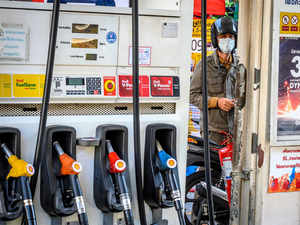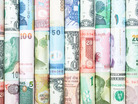 AFP
AFPOne of the unfinished agendas of the current goods and services tax (GST) regime is bringing petrol and diesel under GST. "Centre & states are loathe to bring crude oil products under the GST regime as Sales Tax/VAT on petroleum products is a major source of own tax revenue for them" say SK Ghosh, group chief economic advisor, SBI and his team. "Thus, there is lack of political will to bring crude under the ambit of GST"
Interestingly, no country in the world has a completely transparent mechanism in pricing petroleum products. However, the federal nature of taxing makes estimating state-wise petroleum, oil and Lubricant (POL) related product prices an especially tough exercise for India.
The SBI economists have estimated a base price for petrol and diesel comes out to be Rs 75 and Rs 68 per litre, respectively at pan India level. At this base price, with multiple simulations Centre & States have a revenue deviation from budget estimates by only Rs 1 lakh crore / 0.4 per cent of GDP after adjusting for the increase in consumption with the intended price cut. A dollar increase in the crude oil prices will push up the petrol price by around 50 paise and diesel prices by around 150 paise and bring down the overall deviation by around Rs 1500 crore under our baseline scenario.
The forecast assumes crude price at $60/barrel, dollar at Rs 73, transportation changes of Rs 7.25 for diesel and Rs 3.82 for petrol, dealer commission of Rs 2.53 for diesel and Rs 3.67 for petrol, cess of Rs 30 for petrol and Rs 20 for diesel, with equal division between states and Centre (Rs 15 for states and Centre each for petrol and likewise for diesel at Rs 10) and DST rate at 28 per cent (Centre: 14 per cent, State: 14 per cent), FY'22 petrol consumption growth rate at 10 per cent (year-on-year or y-o-y ), diesel consumption growth rate at 15 per cent y-o-y.
Using this tax structure for FY'22, when Centre and states taxes are already so high, states which have the highest rates lose revenue if they shift to this GST regime. But this flat taxation structure brings in uniformity according to SBI economists' calculations. It brings down the burden of taxes on the common man by almost Rs 10-30 depending on the product consumed and the state in which it is consumed. Additionally, it benefits some states which do not drastically tax their petroleum products, like Uttar Pradesh.
Download The Economic Times News App to get Daily Market Updates & Live Business News.
Download The Economic Times News App to get Daily Market Updates & Live Business News.









 Get Unlimited Access to The Economic Times
Get Unlimited Access to The Economic Times
